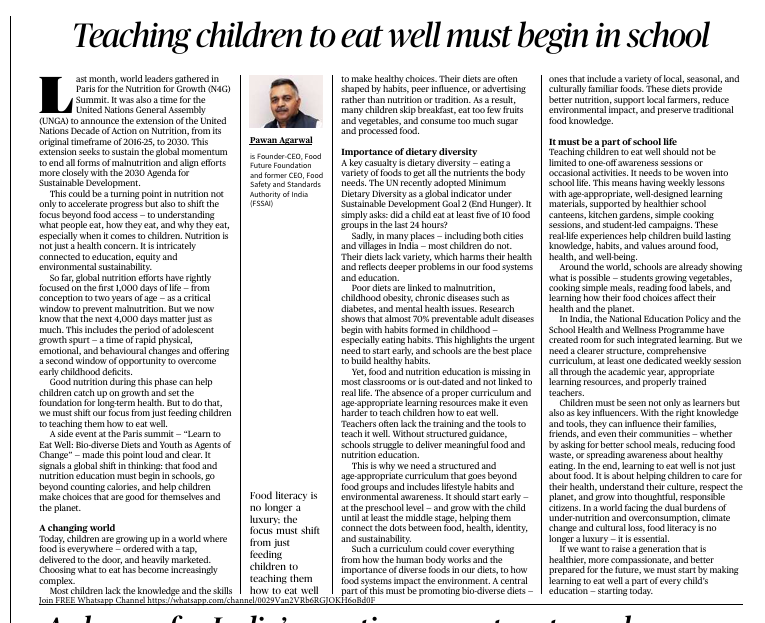Context of the Editorial:
- The editorial is written against the backdrop of the Nutrition for Growth (N4G) Summit in Paris and the UNGA’s extension of the Decade of Action on Nutrition (2016–2025 → 2030).
- It calls for a shift in global nutrition discourse: from access to food to understanding what and how to eat, especially in children and adolescents.
- Emphasizes the critical role of schools in building nutrition literacy and fostering healthy lifelong habits.
📌 Key Themes & Analysis:
1. ✅ Beyond the First 1000 Days – Focus on Adolescence
- Traditional focus in global nutrition has been on the first 1,000 days (conception to age 2) – rightly so.
- But now, science shows that the next 4,000 days (till 18 years) are equally critical.
- Period of rapid growth, emotional and behavioral development.
- Offers a second window of opportunity to overcome early deficits and promote long-term health.
- Period of rapid growth, emotional and behavioral development.
📝 UPSC Linkage: GS II – Welfare schemes for vulnerable sections; GS III – Health.
2. 🍽️ Food Literacy – A Transformative Approach
- Food literacy = Knowing what, why, and how to eat.
- Involves knowledge, skills, and attitudes to make healthy food choices.
- Goes beyond just feeding – includes reading food labels, understanding cooking, and knowing food sources.
- Involves knowledge, skills, and attitudes to make healthy food choices.
- Children’s food choices are shaped by:
- Family habits.
- Marketing/advertising (often unhealthy).
- Cultural traditions.
- Family habits.
📝 UPSC Ethics GS IV Linkage: Responsibility towards future generations, health equity, behavioral ethics.
3. 🥦 Poor Dietary Diversity – A Silent Crisis
- Many Indian children consume monotonous diets, lacking 5 out of 10 food groups
- Leads to:
- Hidden hunger (micronutrient deficiency).
- Childhood obesity, stunting, mental ill-health, and non-communicable diseases.
- 70% of adult disease patterns are linked to childhood diet patterns.
- Hidden hunger (micronutrient deficiency).
- SDG Linkage: SDG 2 (Zero Hunger) + SDG 3 (Good Health and Wellbeing).
📝 UPSC GS III: Food security, malnutrition, non-communicable diseases (NCDs).
4. 🏫 Role of Schools in Nutrition Education
- Currently, food and nutrition education is missing or treated as an occasional awareness activity.
- Real shift needed:
- Make it part of the regular school curriculum.
- Include weekly lessons, simple cooking, reading food labels, school gardens.
- Promote experiential learning and lifelong skills.
- Make it part of the regular school curriculum.
- The NEP 2020 and School Health & Wellness Programme provide a starting point, but:
- Need dedicated weekly sessions.
- Need for trained teachers, clear curriculum.
- Must be hands-on and integrated, not theoretical.
- Need dedicated weekly sessions.
📝 GS II: Government policy & interventions; GS IV: Ethical responsibility of institutions.
5. 🌾 Food as a Sustainability & Identity Issue
- Promoting local, seasonal, traditional foods benefits:
- Health,
- Food security,
- Local livelihoods,
- Environmental sustainability.
- Health,
- Children must develop a relationship with food that connects:
- Culture, health, environment, and identity.
- Culture, health, environment, and identity.
📝 GS III – Agriculture & environment linkages; GS IV – Values: empathy, environmental ethics.
✅ Way Forward:
- Institutionalize food literacy as part of the school system – not just awareness days.
- Train teachers, design curriculum for age-appropriate food education.
- Promote community kitchens, school gardens, and cooking education.
- Encourage multi-sectoral coordination: health + education + agriculture + environment ministries.
- Ensure parent and community involvement to reinforce food education at home.
GS Paper IV – Ethics in Public Life & Society
“Teaching a child how to eat well is an ethical responsibility of society.” Examine the moral and ethical dimensions of childhood nutrition, especially in the context of rising lifestyle diseases and food-related inequalities.


